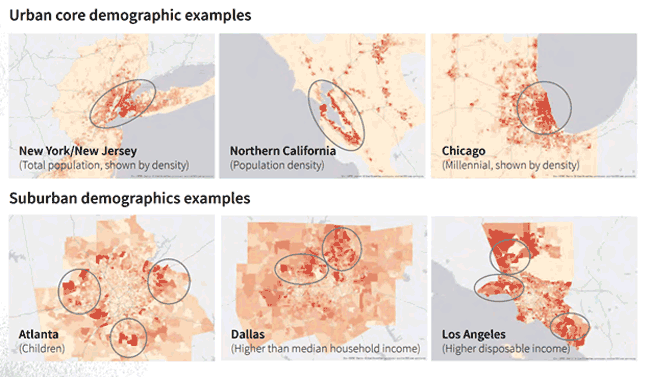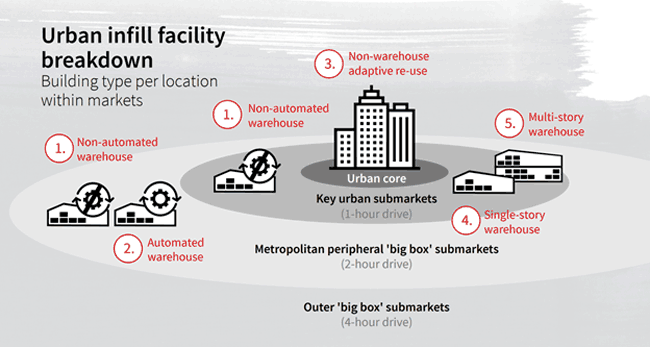Ecommerce and the need for fast, even same ay delivery is rapidly changing logistics, especially in urban markets where increasingly inventory must be positioned locally to meet desired service levels.
Real estate firm JLL (the former Jones Lang Lasalle) uses the term "urban infill" to capture the need for a new approach to last mile deliveries.
Supply Chain Digest Says... |
|
|
In a new report, JLL states that "Having the right urban infill locations will be a big boost to efficiency and keep total landed or delivery costs as low as possible," but notes that there is no one size fits all infill strategy.
And the need for such strategies continues to grow, with ecommerce sales rising around 15% year over year seemingly every quarter, with predictions that on-line sales will double again in less than 10 years if not sooner.
There ae of course many challenges. Congestion is a big one, and the huge growth in efulfillment is creating something of a self-fulfilling prophecy, as the huge growth of delivery stops to individual residences (as opposed to say the number of stops supplying retail stores) itself dramatically increases road congestion and thus delivery costs.
Another challenge: developers can generally get more attractive returns from creating office or retail space in urban markets, not building warehouses. JLL notes, for example, that since 2010, approximately 15% of the existing industrial inventory in Silicon Valley has been repurposed to residential and office space.
Space that is available therefore also becomes very expensive. And there are other sources of costs. For example, the International Parking Institute estimates that in New York City, delivery vehicles rack up 20-30% of the 10 million annual tickets written; FedEx and UPS alone amassed nearly$3 million of fines in the city in just a single quarter a few years ago.
And returns are also a huge logistics issues, as the growth of ecommerce not only adds more opportunity for returns, but return rates, especially in certain product categories such as apparel, are several times higher than for in-store purchases.
For the report, JLL did some interesting research, pulling together data across metro areas on population patterns, ecommerce activity, and available warehouse space.
One of the insights: some of the most strong markets for ecommerce based on population density and income are not only in the urban core but in suburban areas as well, as shown in the chart below:
High eCommerce Markets are in Both Urban and Suburban Areas

Source: JLL
Of course, urban warehousing space will often be quite a bit different than our current models of the modern distribution center.
(See More Below)
|
CATEGORY SPONSOR: SOFTEON |
|
|
| |
|
|
"While having a network of regional distribution centers strategically placed throughout the country is still important, the routing of ecommerce orders and fast-moving consumer goods through a more complex series of facilities is driving demand for all kinds and all qualities of industrial real estate," JLL notes. "Outdated and underutilized no-nindustrial properties are beginning to see reinvention. And markets with higher land values, like the New York, Seattle, Bay Area and Los Angeles metro areas, are starting to turn to multi-story industrial development as a means to meet delivery needs."
However, delivery demands vary widely based on the retailer and the shipper. What is the fast, frequently moving inventory? What is bulky and expensive to ship by delivery truck? Where is the demand for more white glove services?
"Some companies are already starting to answer these questions," JLL says.
Necessity is the mother of invention, and last mile pressures are driving logistics innovation. One idea: shared, sometimes temporary space. The report notes companies such as Flexe, Flow Space and Warehouse Exchange as on-demand, peer-to-peer warehousing start-ups that aim to help shippers lease up their underutilized space by linking together operators that have too much space with those that don't have enough. Often, they are connecting warehouse users with on-demand or seasonal space needs – a retailer with a big holiday push paired with a home gardening supplier, for instance.
UPS has recently announced a similar service.
JLL itself has been engaged on the redevelopment of an underutilized urban parking deck right in the heart of downtown Chicago for efulfillment. The Millennium Mile project will allow ecommerce companies to reach both day time and evening populations within hours or even minutes.
Given the demand, the cost of urban space is rising. So far in 2018 urban infill supply has an 18% sale price premium over all warehouse and distribution supply – up from just an 11% premium in recent years.
In interesting data, the report notes that in JLL-defined US urban infill markets, the last mile warehouse supply is on average 106,400 square feet, was built in the 1970s and has less than 7.7% available space (compared to over 9.5% availability for the total supply in those same markets).
The report also says such space is now not only found in the "warehouse districts" built decades ago in many cities, but right next to office even residential areas of cities.
Th report also notes that "The generally accepted last mile concept of infill buildings in the urban core are often older, outdated warehouses, but they can be unused and underutilized non-warehouses as well - all of these have the potential to become last mile depots if by location, functionality and/or feature they present an innovative opportunity."
This overall distribution landscape is nicely illustrated by JLL in the graphic below:

Source: JLL
The takeaways of all this for shippers?
More than just the box: Existing urban infill warehouse and distribution inventory is extremely scarce. Looking to new, innovative and different types of properties for fulfillment centers will be necessary to achieve last mile delivery.
Fighting through, or figuring out those logistical challenges: Higher costs, congestion problems and environmental concerns that impact e-commerce delivery efficiency will start to be remediated with appropriate urban infill locations.
Cities getting smarter: Public-private partnership should begin to change perceptions about facilities, as municipalities will have to promote logistically efficient and environmentally friendly practices.
The full report is available here: Urban infill: the route to delivery solutions
|